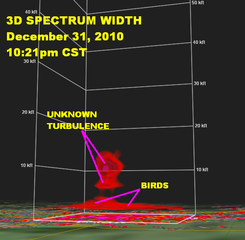
Wildlife officials blamed the sudden death of thousands of red-winged blackbirds on fireworks set off by local New Year's Eve revelers. But NewsChannel5 Chief Meteorologist Mark Johnson wasn't quite convinced.
"Fireworks go off all the time," he said. "This doesn't normally cause hundreds of thousands of birds to leave their roosts in a frenzy... and then fall to their deaths."
Johnson began to look deeper into the event, which was one of several dozen mysterious animal and fish deaths worldwide during late 2010 and early 2011. These events gained international attention for several months this past winter. As the mass death events started piling up, Johnson started an Internet blog chronicling each event.
"I wanted to also explain the likely cause of each of these events in the blog," Johnson added. "Every one of them had a very logical explanation, except for Beebe, Arkansas."
So, he started to dig deeper. Johnson began to examine the Doppler radar images from Beebe, Ark., at the time of the event. The flying birds are easily seen in the two-dimensional imagery. But that's all. Johnson then began to examine the 3D images of the atmosphere over Beebe, Ark., and discovered something interesting.
"There it was. This huge plume of turbulence over the Beebe birds just as they began their frenzied flight," he said.
The turbulence appears above the birds between about 7,000 and 12,000 feet. Johnson realized there are only a few possible explanations for this phenomena. Birds don't fly that high, and he quickly ruled out military action, a sonic boom, meteor shower or alien invasion.
"Something in the atmosphere, something mysterious, occurred over Beebe Arkansas that night," asserted Johnson. "And I believe it was part of what caused those birds to fly and then die."
The 17-year WEWS-TV veteran then posted his discovery on newsnet5.com. That's where it caught the attention of National Geographic "Explorer" producer James Donald, who had already started investigating the strange bird and fish deaths on his own. He is currently producing a 1-hour TV show on the subject for National Geographic Television and interviewed him in the WEWS studios on Tuesday.
"Mark was the only scientist in the country who found this strange radar image." said Donald. "We needed to find out what this was."
That was easier said than done. National Weather Service Meteorologists from around the country were baffled by the image.
"No one could explain it." added Donald.
That was until the Donald presented the data to scientists at the Massachusetts Institute of Technology Lincoln Laboratory. This MIT Lincoln lab is on the cutting edge of the latest Doppler radar technology. At first, even they were unsure.
"We had all of these scientists standing around a radar screen just shaking their heads." Donald recalled. "Even these guys couldn't explain it."
But, after several months examining Johnson's radar images, plus other data from that evening, MIT Scientists finally think they have an explanation for what caused the mass bird deaths in Beebe, Ark.
"It looks like a combination of events that occurred over Beebe at just the right time to scare the birds." said Donald.
Johnson's research captured a unseen temperature reversal just above the birds' roosting area at about 1,500 feet above the ground. This temperature "inversion" acted like a megaphone, amplifying all the noises that occurred in Beebe at that time. As the fireworks exploded, the sound was amplified by the inversion and became much louder than normal. This appears to have startled the birds so much that they burst into flight, running into each other, and nearby buildings. Thousands of the now-disoriented birds then crashed to the ground, dying from blunt force trauma.
"Mark's discovery is the exclamation point on our investigation." added Donald. "If it weren't for him, we would probably never know what caused those birds to die."
Johnson's discovery will also assist researchers in developing better ways to identify potentially dangerous turbulence and inversions in the atmosphere. This also has implications in predicting where storms will develop and where aircraft may encounter disruptive turbulence in their flight path. MIT Lincoln Laboratory will release a 38-page research report describing the discovery in much greater detail late this summer or early fall.
"This is a huge discovery," said Donald.
The program featuring Johnson will air on the National Geographic Channel in fall 2011. The show will be called "Apocalypse over Arkansas." We will keep you posted on the exact date.



Comment: Indeed, Johnson is on to something important here. It's just a shame he couldn't follow through to a logical conclusion...
Reign of Fire: Meteorites, Wildfires, Planetary Chaos and the Sixth Extinction